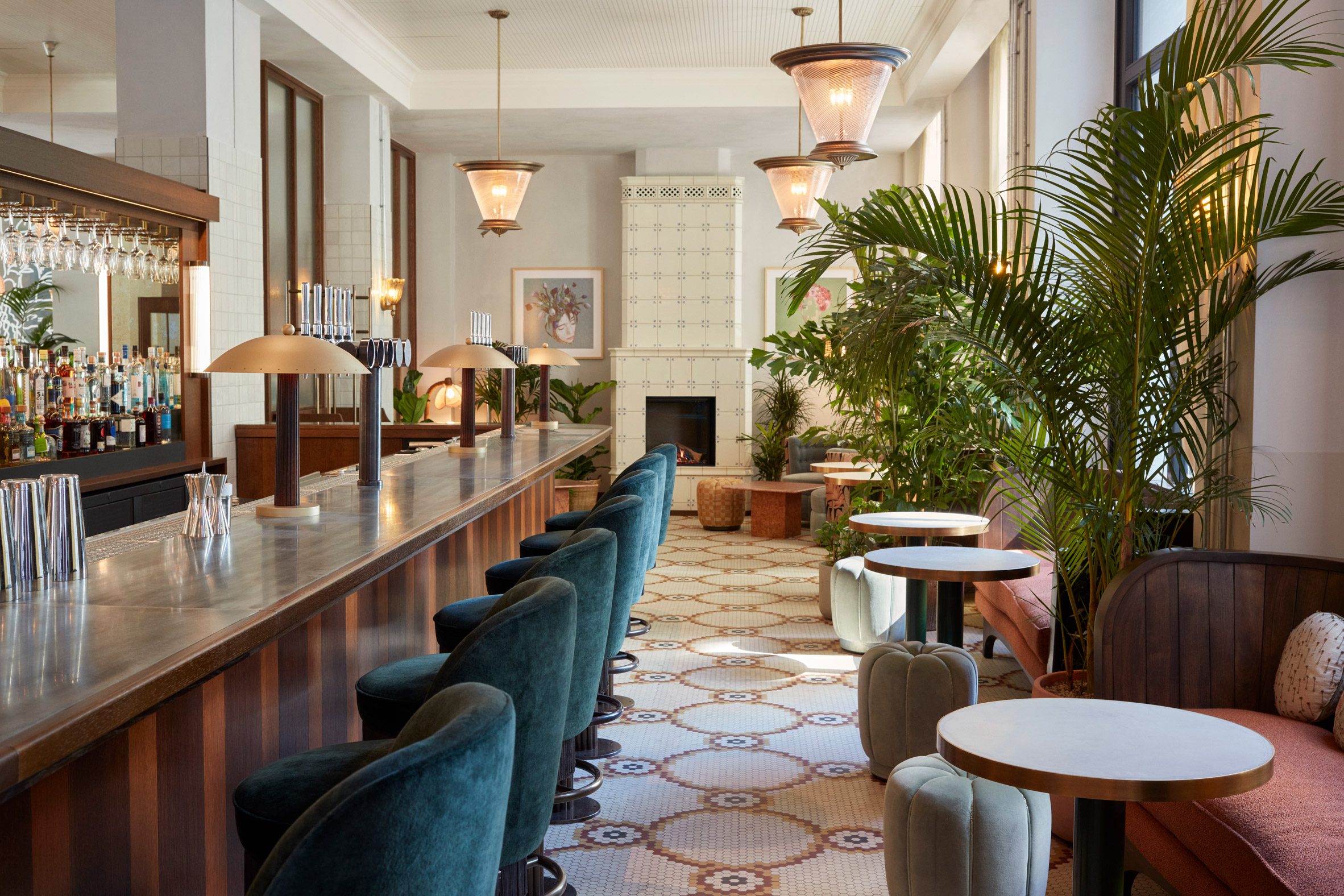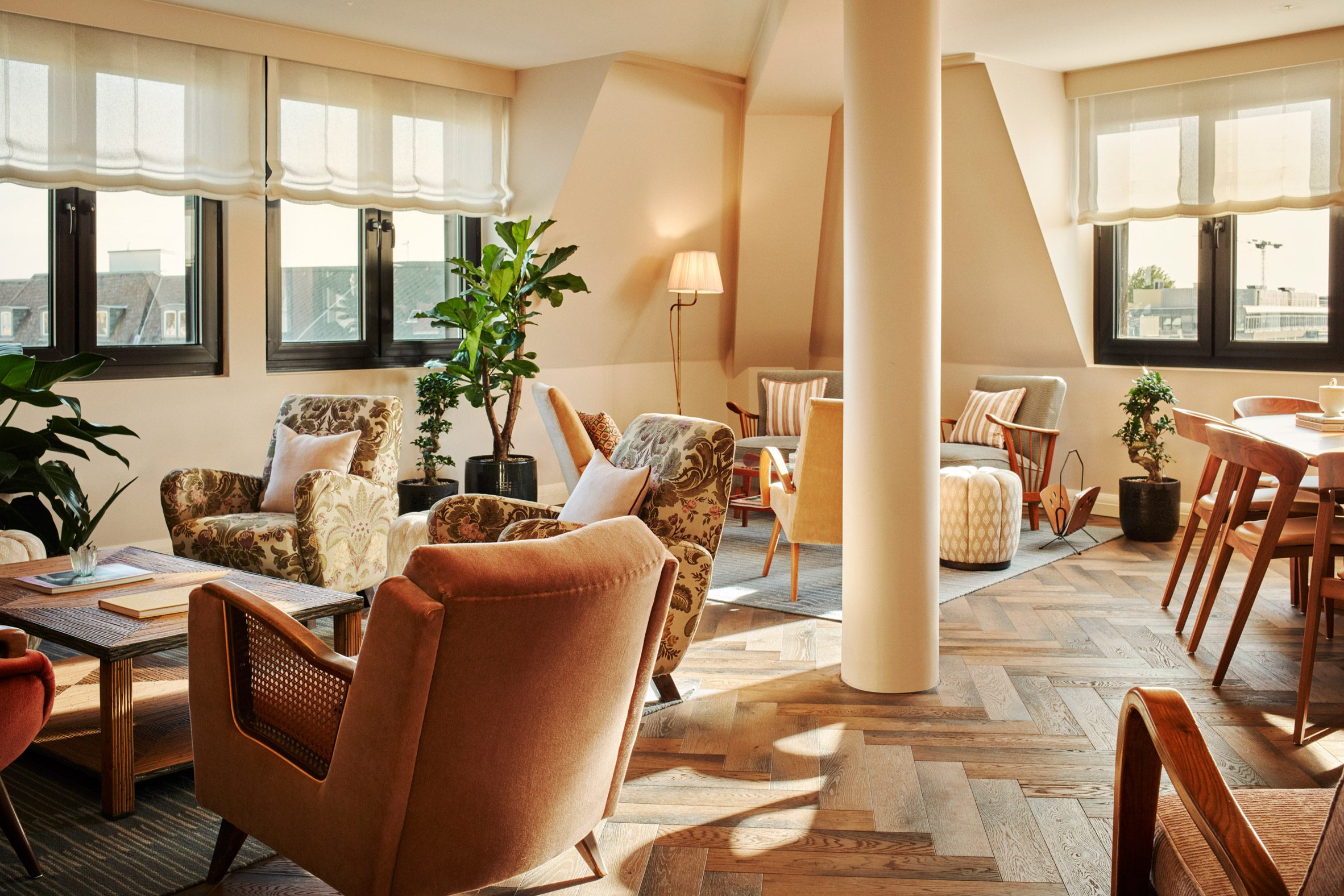[ad_1]

The Hoxton hotel has opened its first German outpost in Berlin’s Charlottenburg, with interiors designed to blend the contrasting architectural styles that rub shoulders in the affluent neighbourhood.
Located just off the Kurfürstendamm shopping street in West Berlin, the 234-room hotel was styled on a cross between the area’s Jugendstil mansion blocks and the comparatively rugged concrete buildings of the brutalist era.

The result is an aesthetic concept that the company’s in-house design team AIME Studios has dubbed “rough nouveau”.
“By drawing inspiration from the surrounding area and celebrating the contrasting styles, we were looking to create a unique interpretation of this corner of the city, which will be recognisable to locals and let visitors get a sense of the area,” AIME Studios design associate Charlie Cruickshank told Dezeen.

Brutalist influences can be seen in the oversized concrete columns that run through The Hoxton’s lobby, which is finished in a textured plaster to match.
This provides a rough backdrop for more elaborate decorative touches, ranging from mosaic flooring to bespoke Murano glass chandeliers with botanical-inspired forms that draw on the art nouveau ironwork and tiling found in the surrounding buildings.

“One of the features we noticed many times while walking around Charlottenburg were the tiled doorways with elaborate designs,” Cruickshank said.
“Tiles are used in many decorative and creative ways throughout the area and they are also integrated into some of our joinery pieces.”

At the back of the blue- and green-toned lobby with its vintage mid-century furniture sits the Winter Garden bar, finished with patterned mosaic tiles to create a conservatory-meets-courtyard atmosphere.
Here, a Delft-inspired tiled fireplace nods to traditional Swedish stoves while fostering a cosy atmosphere during Berlin’s frosty winters.
“The references to the beautiful tiles in the local area were emphasised wherever possible, and the finely painted botanical designs echo classic art nouveau motifs,” Cruickshank said.

Also on the ground floor are the House of Tandoor restaurant and the Teahouse cafe and bar, both designed to fuse the elegant Charlottenburg aesthetic with Indian influences, taking design cues from the grand palaces of Kolkata and Mumbai in the 1920s.
In the cafe, shell-patterned mosaic tiles pick up the subtle green hues in the bar’s marble countertop while oversized windows flood the space with light.
“The show-stopping scalloped marble floor tiles feature colours inspired by Indian spices and herbs that are used for the cocktail menu,” said Cruickshank.

In the next-door restaurant, an open-plan copper-and-wood kitchen takes centre stage alongside richly upholstered banquettes.
Framed vinyl covers and vintage-style gramophones reference India’s jazz era, representing the fusion of Indian and Western cultures.
“The concept for the restaurant is to emulate the vibrant colour palette of the spices and textiles found in the markets of Mumbai as well as the quirky curiosities often found within the markets, such as gramophones,” said Cruickshank.
“This also has a nod to the theatricality of the 1920s Weimar era and the cultural importance of jazz during this time.”

The “rough nouveau” concept continues in the 234 bedrooms, where a restrained take on the whiplash curves of art nouveau can be seen in features such as the headboards while the lighting brings a raw, unpolished element to each room.
A muted colour palette of soft pinks and greens provides a sense of warmth that is amplified by the vintage furniture, herringbone flooring and patterned rugs.

Building on the hotel’s links to its locale are the illuminated room numbers.
“Illuminated house and apartment number signs are a quintessential feature you see all over West Berlin,” Cruickshank said. “Using these signs references this distinctive design marker of the neighbourhood.”

A top-floor party and event space, The Apartment, includes three flexible private rooms arranged around a central kitchen.
The Apartment’s aesthetic was informed by the life and work of Mary Wigman, a German dancer and choreographer who pioneered expressionist dance and lived in West Berlin in the early 20th century.

“We imagined the space to be like a 1920s apartment looking out over the vibrant city with art nouveau influences in the floral and botanical wallpapers and the soft pastel colour palette,” Cruickshank said.
“The location of The Apartment on the top floor of the hotel adds to the residential feel of the space.”

The Hoxton’s other outposts include a hotel informed by the work of Spanish architect Ricardo Bofill in Barcelona and one housed in Chicago’s old meatpacking area.
The photography is courtesy of The Hoxton.
The post The Hoxton Charlottenburg draws on Berlin's brutalist and art nouveau architecture appeared first on Dezeen.
[ad_2]
www.dezeen.com










